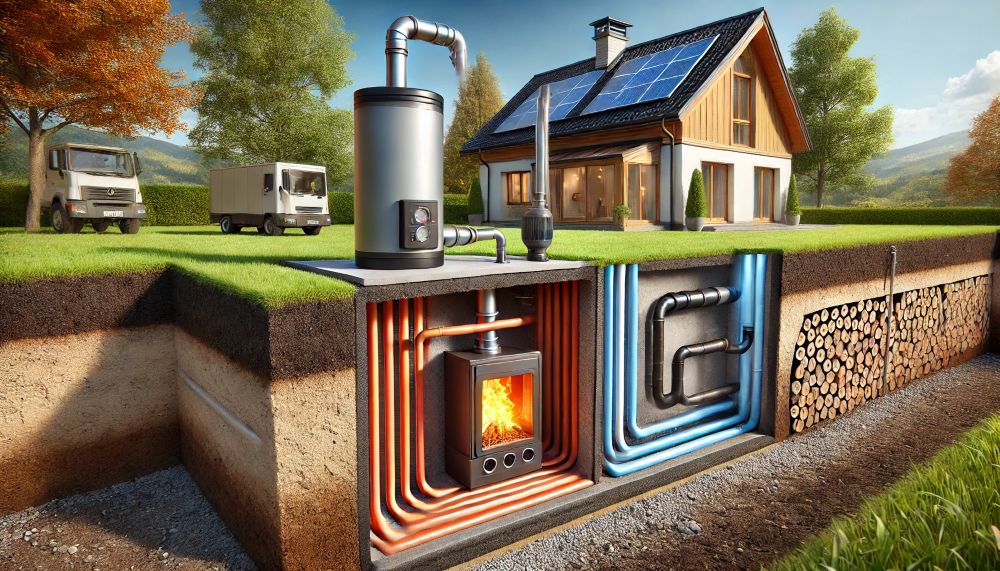In today’s drive for sustainable and energy-efficient heating systems, modern homeowners and industry professionals are increasingly turning to innovative solutions that combine traditional methods with modern technology. A prime example is the integration of underground insulated PEX pipe with outdoor wood boilers and circulation pumps. This system not only enhances energy efficiency but also minimizes environmental impact while offering robust, long-lasting performance. This article explores the benefits, technology, and installation techniques that make these components essential in contemporary heating systems.
1. Understanding Underground Insulated PEX Pipes
1.1 What Are PEX Pipes?
Cross-linked polyethylene (PEX) pipes have revolutionized the plumbing and heating industry due to their flexibility, durability, and resistance to corrosion. When installed underground, these pipes are typically insulated to safeguard against extreme temperature variations and potential freezing. Insulated PEX pipes ensure that the water circulating through the system maintains its temperature, significantly reducing energy loss.
1.2 Advantages of Insulation
Insulation is crucial for maintaining the efficiency of underground PEX systems. By minimizing heat loss, insulated PEX pipes provide several benefits:
- Energy Efficiency: Reduced heat loss means the heating system operates with greater energy efficiency.
- Extended Lifespan: Insulation protects the pipes from freeze-thaw cycles and external environmental factors, extending their operational life.
- Cost Savings: With less energy wasted, homeowners benefit from reduced energy bills over time.
1.3 Installation and Maintenance
Installing underground insulated PEX pipes requires careful planning. Key considerations include:
- Depth of Burial: Pipes must be installed below the frost line to prevent freezing.
- Proper Insulation Material: Selecting the right insulation material ensures optimal thermal retention.
- Regular Inspections: Maintenance checks are necessary to ensure that the insulation remains intact and that there are no leaks or damages to the piping system.
2. The Role of Outdoor Wood Boilers in Modern Heating
2.1 What Is an Outdoor Wood Boiler?
An outdoor wood boiler is a heating system that uses wood as its primary fuel source to heat water. The water is then circulated through insulated pipes to distribute warmth throughout a building. Outdoor wood boilers are especially popular in rural or off-grid settings where wood is abundant and energy independence is a priority.
2.2 Benefits of Using an Outdoor Wood Boiler
Outdoor wood boilers offer numerous advantages:
- Cost-Effective Fuel Source: Wood is often less expensive than fossil fuels.
- Eco-Friendly: Wood is a renewable resource and produces less carbon dioxide compared to traditional heating fuels.
- Efficiency: Modern outdoor wood boilers are designed to maximize heat output while reducing emissions.
- System Longevity: When paired with insulated PEX piping, the overall system operates efficiently with a longer lifespan.
2.3 Integrating with Other Heating Components
For optimal performance, an outdoor wood boiler is integrated with a circulation pump. This combination ensures that the heated water is effectively distributed throughout the system, reaching all areas that require warmth. The synergy between the boiler and the insulated PEX pipes is key to achieving a balanced and efficient heating network.
3. The Importance of Circulation Pumps
3.1 How Circulation Pumps Work
Circulation pumps are vital for moving heated water from the boiler through the insulated PEX pipes and back to the boiler in a continuous cycle. These pumps ensure that the entire heating system operates uniformly, preventing cold spots and maximizing energy use.
3.2 Key Features and Benefits
Modern circulation pumps come with several features that enhance system performance:
- Variable Speed Control: Allows for adjustments in water flow based on heating demand.
- Energy Efficiency: Designed to operate with minimal power consumption.
- Durability: Built to withstand harsh outdoor conditions and continuous operation.
- Ease of Integration: Seamlessly connects with both outdoor wood boilers and underground PEX piping systems.
3.3 Maintenance and Troubleshooting
Routine maintenance of circulation pumps includes:
- Regular Inspections: Check for wear and tear, unusual noises, or vibration.
- Cleaning: Prevent debris buildup that could impair performance.
- Professional Servicing: Periodic professional check-ups ensure that the pump runs efficiently and safely over time.
4. Outdoor Boilers: Enhancing Overall System Efficiency
4.1 What Are Outdoor Boilers?
Outdoor boilers function similarly to indoor wood boilers but are designed specifically for external installation. Their design often includes enhanced weatherproofing and integration capabilities with other outdoor heating components, such as insulated PEX pipes and circulation pumps.
4.2 Advantages of Outdoor Boilers
- Reduced Indoor Noise: Being located outdoors minimizes operational noise inside the building.
- Space Efficiency: Frees up indoor space that might otherwise be occupied by bulky heating systems.
- Improved Air Quality: By keeping combustion processes outside, indoor air quality is maintained.
4.3 Combining with Insulated PEX and Circulation Pumps
The integration of outdoor boilers with underground insulated PEX pipes and high-performance circulation pumps creates a cohesive system. This combination ensures efficient heat transfer, energy conservation, and long-term reliability, making it an ideal choice for sustainable heating solutions.
5. System Integration: Best Practices and Considerations
5.1 Designing the System
A well-designed heating system starts with careful planning:
- Layout Planning: Determine the optimal route for underground PEX pipes to connect all heating zones.
- Component Sizing: Ensure that the outdoor wood boiler, circulation pump, and insulated PEX pipes are appropriately sized for the building’s heating requirements.
- Safety and Compliance: Follow local building codes and standards to guarantee a safe installation.
5.2 Installation Process
Professional installation is crucial:
- Site Preparation: Prepare the site to allow for efficient underground piping installation.
- Component Assembly: Connect the outdoor boiler, circulation pump, and insulated PEX pipes with precision to avoid leaks.
- Testing: Conduct thorough testing to ensure the system is fully operational and free from faults.
5.3 Long-Term Maintenance
Ongoing maintenance is essential for preserving system efficiency:
- Regular Check-ups: Schedule seasonal inspections to check the integrity of the insulation, pipes, and boiler.
- Prompt Repairs: Address any signs of wear or damage immediately to prevent further complications.
- Upgrades: Consider upgrading components over time to take advantage of advances in technology and energy efficiency.
Integrating underground insulated PEX pipes, outdoor wood boilers, and circulation pumps into a unified heating system offers a sustainable, energy-efficient solution for modern homes. This approach not only reduces energy consumption and operational costs but also promotes environmental sustainability. With proper planning, professional installation, and regular maintenance, such systems can provide reliable heating for years to come, ensuring comfort and efficiency in every season.


